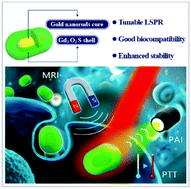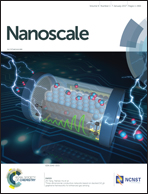Gadolinium oxysulfide-coated gold nanorods with improved stability and dual-modal magnetic resonance/photoacoustic imaging contrast enhancement for cancer theranostics†
Abstract
Gold nanorods (GNRs) are emerging as a promising nanoplatform for cancer theranostics because of their unique optical properties. However, they still suffer from many limitations, such as high cytotoxicity, low thermodynamic and biological stability, and a tedious process for integrating other imaging modalities, for further practical biomedical applications. In this work, a strategy by one-step coating of Gd2O2S around GNRs is reported to address these limitations of GNRs. After the coating of the Gd2O2S shell, the as-fabricated Gd2O2S coated GNRs (GNRs@Gd2O2S) show enhanced biocompatibility and photostability, and tunable localized surface plasmon resonance. The strong absorption in the near-infrared region renders GNRs@Gd2O2S outstanding photoacoustic imaging and photothermal therapy capabilities. Moreover, owing to the T1 shortening ability of Gd2O2S, the GNRs@Gd2O2S also show an excellent T1 MRI contrast performance. The GNRs@Gd2O2S thus can serve as a versatile nanoplatform for cancer theranostics combining dual-modal imaging and photothermal therapy.


 Please wait while we load your content...
Please wait while we load your content...